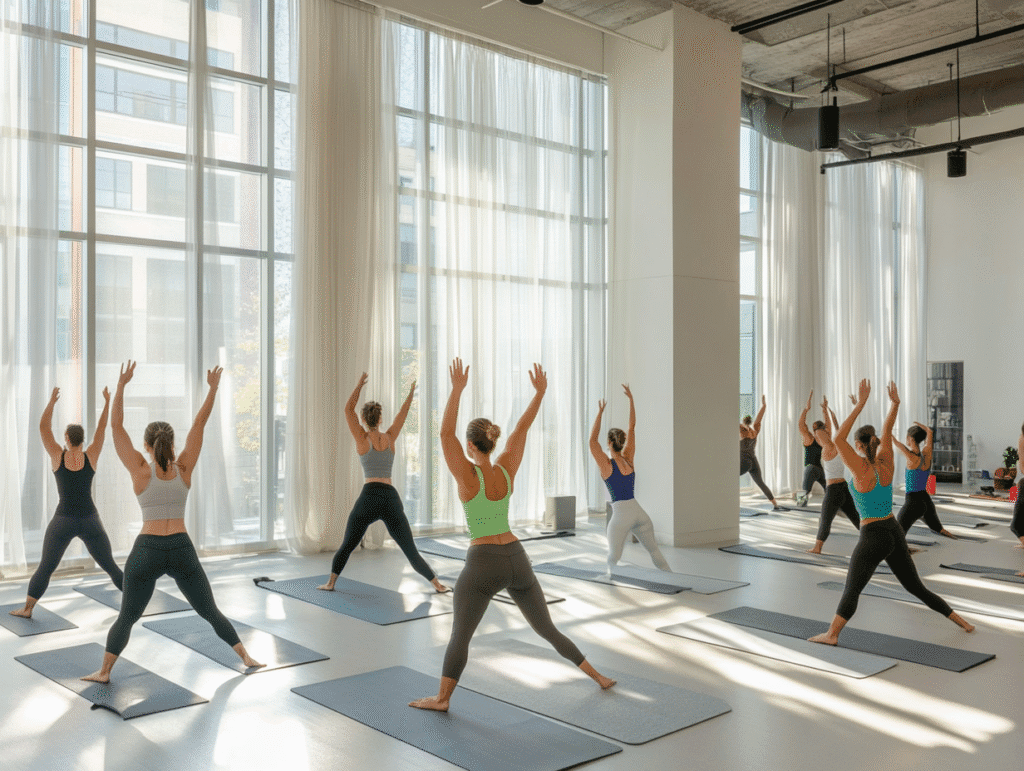
Understanding Nylon Spandex Fabric
What Is Nylon Spandex Fabric?
Nylon Spandex fabric is a synthetic blend primarily composed of nylon (polyamide) and spandex (elastane). The combination typically ranges from 80-90% nylon for strength and structure, and 10-20% spandex for elasticity.
Key Characteristics:
- Stretchability – The spandex content allows the fabric to stretch up to 500% of its original size**, making it ideal for form-fitting garments.
- Durability – Nylon provides high resistance to wear, tear, and abrasion, ensuring long-lasting performance.
- Moisture-Wicking – The fabric efficiently pulls sweat away from the skin, keeping wearers dry during physical activity.
- Lightweight & Smooth Texture – Offers a soft, smooth feel against the skin, enhancing comfort.
- Quick-Drying – Unlike cotton, it dries rapidly, making it perfect for swimwear and activewear.
Common Applications
Nylon Spandex is a versatile fabric used across multiple industries due to its flexibility, strength, and comfort.
1. Activewear
- Why? The fabric’s 4-way stretch allows full range of motion, while moisture-wicking keeps athletes dry.
- Examples: Yoga pants, running leggings, sports bras.
2. Swimwear
- Why? Resistant to chlorine, saltwater, and UV rays, while maintaining shape after repeated use.
- Examples: Swimsuits, board shorts, rash guards.
3. Lingerie & Shapewear
- Why? Provides a second-skin fit, offering support without discomfort.
- Examples: Seamless underwear, compression bodysuits.
4. Athleisure & Casual Wear
- Why? Combines comfort and style, making it suitable for both workouts and everyday wear.
- Examples: Joggers, hoodies, fitted tops.
Why Brands Choose Nylon Spandex:
✅ Performance-Driven – Ideal for high-movement apparel.
✅ Consumer Demand – Stretch and comfort are top priorities for modern shoppers.
✅ Durability – Reduces returns and increases customer satisfaction.
✅ Versatility – Works for multiple product categories.
Key Factors to Consider When Choosing Nylon Spandex
Fabric Weight and Thickness
The weight and thickness of nylon spandex fabric directly impact its functionality, drape, and suitability for different garments.
- Lightweight (100-200 gsm)
- Best for: Activewear, swimwear, lingerie
- Benefits: Highly breathable, flexible, and comfortable for high-movement activities.
- Example: Yoga leggings, bikinis, seamless underwear
- Medium Weight (200-300 gsm)
- Best for: Athleisure, compression wear, casual sportswear
- Benefits: Balances stretch and structure, ideal for everyday wear.
- Example: Joggers, fitted tops, lightweight outer layers
- Heavyweight (300+ gsm)
- Best for: Performance outerwear, winter activewear, shapewear
- Benefits: Provides warmth, compression, and durability.
- Example: Running tights, high-support sports bras, thermal base layers
Why It Matters:
✔ Too thin? May lack opacity or durability.
✔ Too thick? Could restrict movement or reduce breathability.
✔ Match weight to function—e.g., lightweight for yoga, heavyweight for compression.
Stretch and Recovery
A fabric’s stretch and recovery determine how well it maintains shape after repeated use.
- Spandex Percentage (10-20% is typical)
- 10-15%: Moderate stretch (good for casual wear, some activewear).
- 15-20%: High stretch (best for performance wear, swimwear).
- >20%: Extreme stretch (used in compression garments).
- Testing Recovery
- Stretch Test: Pull fabric to its limit—does it return to original shape?
- Wash Test: After multiple washes, does it sag or lose elasticity?
- Longevity Check: Poor recovery leads to baggy knees in leggings or loose waistbands.
Why It Matters:
✔ Good recovery = longer garment lifespan.
✔ Low-quality spandex degrades faster, leading to customer complaints.
Durability and Performance
Nylon spandex should withstand wear, washing, and environmental factors.
- Abrasion Resistance
- Test by rubbing fabric against rough surfaces—does it pill or fray?
- Critical for activewear, cycling shorts, backpacks.
- Pilling Tests
- Use a Martindale tester or wash repeatedly to check for fuzz balls.
- High-quality nylon resists pilling better than cheap blends.
- Colorfastness & UV Resistance
- Colorfastness: Will dye bleed in sweat or after washing? (Test with bleach or detergent.)
- UV Resistance: Important for swimwear and outdoor activewear—prevents fading.
Why It Matters:
✔ Durable fabric = fewer returns, better brand reputation.
✔ Fading or pilling leads to negative reviews.
Comfort and Breathability
Even performance fabrics must feel good on the skin.
- Moisture Management
- Does it wick sweat away quickly?
- Look for micro-porous or mesh weaves for better airflow.
- Softness & Skin-Friendly Finishes
- Brushed interior (for warmth and comfort).
- Antimicrobial treatments (to prevent odor).
- Oeko-Tex certified (no harmful chemicals).
Why It Matters:
✔ Breathable fabric keeps customers cool during workouts.
✔ Rough or non-wicking fabric causes discomfort and chafing.
Key Takeaways for Brands:
Comfort → Prioritize moisture-wicking and soft finishes.
Weight → Choose based on garment type (light for yoga, heavy for outerwear).
Stretch & Recovery → Higher spandex = better stretch, but test recovery.
Durability → Check abrasion, pilling, and colorfastness.
Aligning Fabric Choice with Brand Values
Sustainability Considerations
Today’s consumers demand eco-friendly fabrics, making sustainability a key factor in material selection.
1. Recycled Nylon vs. Conventional Nylon
- Recycled Nylon (e.g., ECONYL®)
- Made from regenerated waste (fishing nets, fabric scraps, industrial plastic).
- Reduces ocean pollution and carbon footprint by up to 50% compared to virgin nylon.
- Best for: Eco-conscious brands targeting Gen Z and Millennial shoppers.
- Conventional Nylon
- Derived from petroleum, with higher environmental impact.
- Still useful for: Budget-friendly lines where sustainability isn’t a core selling point.
2. Key Certifications to Look For
- Oeko-Tex Standard 100 → Ensures no harmful chemicals (safe for skin contact).
- Bluesign® → Covers sustainable production (water/energy efficiency, toxin-free dyes).
- Global Recycled Standard (GRS) → Verifies recycled content percentage.
Why It Matters:
✔ Sustainability sells – 60% of consumers prefer eco-friendly activewear (Nielsen).
✔ Certifications build trust – They prove your brand’s commitment to ethical practices.
Cost vs. Quality Balance
Choosing the right nylon spandex involves balancing affordability with performance.
1. Budget Constraints vs. Customer Expectations
- Low-Cost Fabric (Under $5/yd)
- May have lower spandex content (≤10%), weaker recovery, or fewer certifications.
- Risk: Higher returns due to pilling or stretching out.
- Mid-Range ($5-$10/yd)
- Better durability, smoother finishes, and reliable stretch.
- Sweet spot for startups and mid-tier brands.
- Premium ($10+/yd)
- Features like UV protection, antimicrobial treatments, or recycled content.
- Best for: Luxury activewear or performance-driven brands.
2. Long-Term Value of High-Quality Fabric
- Fewer Returns – Durable fabric means fewer complaints about wear and tear.
- Brand Reputation – Customers remember quality and may pay more next time.
- Less Waste – Longer garment life = more sustainable, even if initial cost is higher.
Cost-Saving Tips Without Sacrificing Quality:
✔ Order in bulk – Suppliers often offer discounts for larger quantities.
✔ Negotiate MOQs – Some mills accept lower minimums for blended orders.
✔ Test rigorously – Avoid costly mistakes by sampling before full production.
Key Takeaways for Brands:
Premium fabrics can justify higher price points – If aligned with brand positioning.
Sustainable options like ECONYL® appeal to eco-aware shoppers – Certifications add credibility.
Cheaper fabric may cost more long-term – Balance budget with durability needs.
Sourcing and Supplier Selection
Finding Reliable Suppliers
Choosing the right supplier is crucial for quality consistency, ethical production, and on-time delivery.
Key Questions to Ask Potential Suppliers:
- Minimum Order Quantity (MOQ)
- “What is your minimum yardage per color/style?”
- Many mills require 500-1,000 yards per order, but some accept smaller quantities for startups.
- Lead Times & Production Capacity
- “How long does production take from order to shipment?”
- Standard lead time: 4-8 weeks (longer for custom fabrics).
- “Can you handle rush orders if needed?”
- Fabric Specifications
- “What’s the exact nylon/spandex ratio?”
- “Do you offer recycled or certified (Oeko-Tex, Bluesign) options?”
- Pricing & Payment Terms
- “What’s the cost per yard at different order volumes?”
- “Do you offer discounts for long-term contracts?”
- “What payment methods do you accept?” (e.g., 30% deposit, 70% before shipment).
- Quality Control & Compliance
- “Do you provide lab test reports (for stretch, colorfastness, etc.)?”
- “Are your factories audited for ethical labor practices?”
Red Flags to Watch For:
❌ Unusually low prices (may indicate poor quality).
❌ Refusal to provide fabric certifications or samples.
❌ Lack of communication or slow response times.
Requesting Samples
Never skip sampling! Testing fabric before bulk ordering prevents costly mistakes.
Step-by-Step Sampling Process:
- Request Swatches or Yardage
- Ask for at least 1-yard samples of each fabric option.
- Confirm if samples are free or paid (typical cost: $10-$50 per swatch).
- Conduct Physical Tests
- Stretch & Recovery → Stretch to max capacity and check if it bounces back.
- Wash Test → Machine wash 3-5 times to check for shrinkage or fading.
- Abrasion Test → Rub fabric with a rough surface (e.g., Velcro) to test pilling.
- Color Transfer → Wet the fabric and press it against white paper to check dye bleed.
- Sew a Prototype
- Make a sample garment to assess drape, comfort, and fit.
- Have fit models test it during movement (e.g., squatting for leggings).
- Evaluate Supplier Responsiveness
- Did they deliver samples on time?
- Were they open to feedback or adjustments?
Questions to Answer Before Bulk Ordering:
✔ Does the fabric meet your brand’s quality standards?
✔ Can the supplier consistently deliver this quality?
✔ Are there any hidden costs (shipping, duties)?
Key Takeaways for Brands:
- Vet suppliers thoroughly – Ask about MOQs, lead times, and compliance.
- Test samples rigorously – Stretch, wash, and rub fabrics to mimic real-world use.
- Prioritize communication – A reliable supplier should be responsive and transparent.
Conclusion: Making the Right Choice for Your Brand
Selecting the perfect nylon spandex fabric for your brand requires balancing performance, sustainability, and cost while staying true to your brand’s identity. Let’s recap the key takeaways:
- Performance Matters Most
- Prioritize stretch, recovery, and durability based on your garment’s purpose (e.g., activewear needs high elasticity, while outerwear requires abrasion resistance).
- Test fabrics rigorously—stretch, wash, and rub samples to ensure they meet quality standards.
- Sustainability is a Competitive Advantage
- Recycled nylon (like ECONYL®) appeals to eco-conscious consumers and reduces environmental impact.
- Certifications (Oeko-Tex, Bluesign, GRS) build trust and verify ethical production.
- Cost vs. Quality: Think Long-Term
- Cheaper fabrics may save money upfront but lead to higher returns if they pill, fade, or lose shape.
- Invest in higher-quality materials for premium brands—your customers will notice the difference.
- Supplier Collaboration is Key
- Work closely with reliable suppliers who offer transparency, fair MOQs, and consistent quality.
- Never skip sampling—prototype and test fabrics before committing to bulk orders.
Final Tip: Align Fabric with Your Brand’s DNA
Your fabric choice should reflect your brand’s values and customer expectations. Whether you’re a luxury activewear label focusing on premium performance or a sustainable streetwear brand using recycled materials, the right nylon spandex will help you deliver quality, build loyalty, and stand out in the market.
Next Steps:
- Request samples from shortlisted suppliers.
- Test, compare, and refine before finalizing your selection.
- Communicate your fabric story—consumers appreciate transparency about quality and sustainability.
By making an informed decision, you’ll ensure your products look great, perform well, and keep customers coming back.
